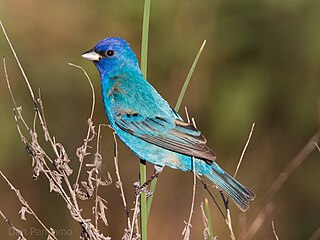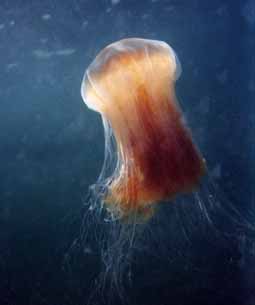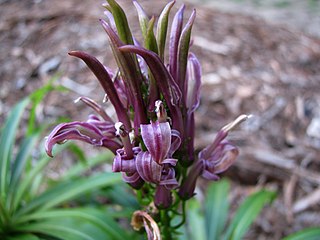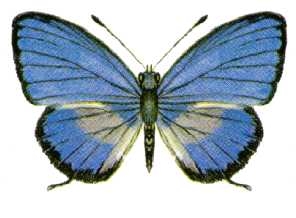
The indigo bunting is a small seed-eating bird in the cardinal family, Cardinalidae. It is migratory, ranging from southern Canada to northern Florida during the breeding season, and from southern Florida to northern South America during the winter. It often migrates by night, using the stars to navigate. Its habitat is farmland, brush areas, and open woodland. The indigo bunting is closely related to the lazuli bunting and interbreeds with the species where their ranges overlap.

The lion's mane jellyfish, also known as the giant jellyfish, arctic red jellyfish, or the hair jelly, is one of the largest known species of jellyfish. Its range is confined to cold, boreal waters of the Arctic, northern Atlantic, and northern Pacific Oceans. It is common in the English Channel, Irish Sea, North Sea, and in western Scandinavian waters south to Kattegat and Øresund. It may also drift into the southwestern part of the Baltic Sea. Similar jellyfish – which may be the same species – are known to inhabit seas near Australia and New Zealand. The largest recorded specimen was measured off the coast of Massachusetts in 1870 and had a bell with a diameter of 210 centimetres and tentacles around 36.6 m (120 ft) long. Lion's mane jellyfish have been observed below 42°N latitude for some time in the larger bays of the east coast of the United States.

The southern hawker or blue hawker is a species of hawker dragonfly.

The Cyaneidae are a family of true jellyfish. About 20 species are in this family, including the well-known lion's-mane jellyfish.

The Pygora goat is a breed of goat that originated from crossing the registered NPGA Pygmy goat and the white AAGBA Angora goat. Pygoras, along with the Angora goat and Cashmere goat, are fiber goats. Pygora goats produce three distinct kinds of fleece.

The Hawaiian lobelioids are a group of flowering plants in the bellflower family, Campanulaceae, all of which are endemic to the Hawaiian Islands. This is the largest plant radiation in the Hawaiian Islands, and indeed the largest on any island archipelago, with over 125 species. The six genera can be broadly separated based on growth habit: Clermontia are typically branched shrubs or small trees, up to 7 metres (23 ft) tall, with fleshy fruits; Cyanea and Delissea are typically unbranched or branching only at the base, with a cluster of relatively broad leaves at the apex and fleshy fruits; Lobelia and Trematolobelia have long thin leaves down a single, non-woody stem and capsular fruits with wind-dispersed seeds; and the peculiar Brighamia have a short, thick stem with a dense cluster of broad leaves, elongate white flowers, and capsular fruits.

The pygora beetles or flower beetles are scarab beetles of the genus Pygora. They are native to Madagascar.

Octopus cyanea, also known as the big blue octopus or day octopus, is an octopus in the family Octopodidae. It occurs in both the Pacific and Indian Oceans, from Hawaii to the eastern coast of Africa. O. cyanea grows to 16 cm in mantle length with arms to at least 80 cm. This octopus was described initially by the British zoologist John Edward Gray in 1849; the type specimen was collected off Australia and is at the Natural History Museum in London.

The reddish-gray musk shrew is a species of mammal in the family Soricidae. It is found in Angola, Botswana, Democratic Republic of the Congo, Eswatini, Lesotho, Malawi, Mozambique, Namibia, Nigeria, South Africa, Tanzania, Zambia, and Zimbabwe. Its natural habitats are temperate forests, subtropical or tropical moist lowland forest, subtropical or tropical high-altitude grassland, and caves.

Chrysiptera cyanea is a species of damselfish native to the Indian and western Pacific Oceans. Common names include blue damselfish, blue demoiselle, blue devil, cornflower sergeant-major, Hedley's damselfish, red tail Australian damsel, sapphire devil, and sky-blue damsel.

Cyanea is a genus of flowering plants in the family Campanulaceae. The name Cyanea in Hawaiian is hāhā. These Hawaiian lobelioids are endemic to Hawaii with over 90% of Cyanea species are found only on one island in the Hawaiian chain. They grow in moist and wet forest habitat and are largely pollinated by birds such as the Hawaiian honeycreepers, and the seeds are dispersed by birds that take the fruits. Most Cyanea are trees with few branches or none. The inflorescence is a raceme of 4 to 45 flowers which grows from the leaf axils. The fruit is a fleshy berry. There have been several theories regarding the evolution of large prickles on plants endemic to islands that lack any mammalian or reptilian herbivores. One such theory suggests that the prickles are a defense against herbivory by the moa-nalo, a few taxa of flightless ducks that went extinct on the islands within the last 1600 years.

Nacaduba cyanea, the tailed green-banded line-blue, is a species of butterfly in the family Lycaenidae, and formerly considered a member of the genus Danis. It is found in the Indonesia, Papua New Guinea, the Solomon Islands and Australia (Queensland).
Pygora bourgoini is a species of Scarabaeidae, the dung beetle family.
Pygora brunneitarsis is a species of Scarabaeidae, the dung beetle family.
Pygora cruralis is a species of Scarabaeidae, the dung beetle family.











